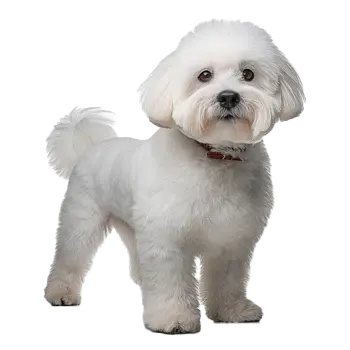The Bichon Tenerife is generally a healthy, long-lived breed with a life expectancy of 14 to 15 years, though some individuals live into their late teens with excellent care. Like all purebred dogs, Bichons are predisposed to certain genetic health conditions that responsible breeders screen for to reduce incidence in their breeding lines. Prospective owners should seek breeders who perform recommended health testing and provide health clearances for breeding dogs. Regular veterinary care, appropriate nutrition, proper grooming, and attentive health monitoring help ensure Bichons enjoy long, healthy lives as beloved companions.
Hip dysplasia, a developmental malformation of the hip joint, can occur in Bichons though it is less common in toy and small breeds than in larger dogs. This condition can cause arthritis, pain, and mobility issues as dogs age. Responsible breeders have their breeding dogs evaluated by the Orthopedic Foundation for Animals (OFA) or through PennHIP screening to reduce hip dysplasia incidence. Luxating patella, a condition where the kneecap dislocates from its normal position in the groove of the thighbone, affects some Bichons and can range from mild to severe, sometimes requiring surgical correction to prevent arthritis and pain.
Eye conditions including cataracts and progressive retinal atrophy (PRA) occur in the breed. Cataracts cause cloudiness of the eye lens and can lead to vision impairment or blindness if untreated. PRA is a group of genetic diseases causing gradual vision loss leading to complete blindness. Responsible breeders have their dogs examined annually by board-certified veterinary ophthalmologists and register results with the Canine Eye Registration Foundation (CERF). Genetic testing for known forms of PRA helps breeders make informed breeding decisions to reduce disease incidence.
Bladder stones, particularly calcium oxalate stones, occur more frequently in Bichons than in many other breeds. These stones can cause urinary tract infections, blood in urine, difficulty urinating, and potentially life-threatening urinary blockages. Dietary management, adequate hydration, and regular veterinary monitoring help reduce stone formation risk. Signs of urinary problems require immediate veterinary attention to prevent serious complications. Allergies, both environmental and food-related, commonly affect Bichons and may cause skin irritation, itching, ear infections, and gastrointestinal upset. Identifying and managing allergens through diet trials, allergy testing, and appropriate medical treatment helps maintain quality of life.
Dental disease is particularly prevalent in small breeds including the Bichon, with many dogs developing periodontal disease by age three without proper dental care. Tartar buildup leads to gum inflammation, tooth loss, and bacteria entering the bloodstream, potentially affecting heart, liver, and kidneys. Daily tooth brushing, dental chews, and regular professional cleanings under anesthesia help prevent serious dental problems. Cushing's disease (hyperadrenocorticism), a hormonal disorder causing the body to produce excessive cortisol, occasionally affects Bichons, particularly as they age. Symptoms include increased thirst and urination, increased appetite, hair loss, and pot-bellied appearance. Diabetes mellitus can develop in Bichons, particularly those that are overweight or have had Cushing's disease.
Regular veterinary examinations are essential for maintaining Bichon health throughout their lives. Annual wellness visits for adult dogs and twice-yearly examinations for senior dogs (typically defined as over age seven) allow veterinarians to detect potential problems early when they are most treatable. Wellness visits should include thorough physical examinations, body condition assessment, dental evaluation, and discussion of any health or behavior concerns. Vaccinations should be kept current based on veterinary recommendations and the dog's lifestyle and risk factors.
Weight management is crucial for Bichon health, as excess weight exacerbates many health conditions including joint problems, diabetes, and heart disease. Maintaining appropriate body condition through portion control and regular exercise prevents obesity-related health issues. Parasite prevention including heartworm preventatives, flea and tick control, and deworming should be administered year-round according to veterinary protocols. Heartworm disease is preventable through monthly preventatives and is far easier and less expensive to prevent than to treat.
Genetic health testing of breeding dogs helps reduce the incidence of hereditary conditions in future generations. Prospective owners should ask breeders for health clearances including hip evaluations, eye examinations by board-certified veterinary ophthalmologists, and any breed-specific genetic tests. Reputable breeders should willingly provide documentation of health testing and discuss any health concerns present in their breeding lines. With proactive health management, regular veterinary care, appropriate preventative measures, and attention to the breed's specific health concerns, most Bichon Tenerife dogs enjoy long, active, healthy lives as treasured family companions, often remaining playful and spry well into their senior years.
Common Health Issues
- Hip dysplasia, a developmental malformation of the hip joint, can occur in Bichons though it is less common in toy and small breeds than in larger dogs.
- Responsible breeders have their breeding dogs evaluated by the Orthopedic Foundation for Animals (OFA) or through PennHIP screening to reduce hip dysplasia incidence.
- Allergies, both environmental and food-related, commonly affect Bichons and may cause skin irritation, itching, ear infections, and gastrointestinal upset.
- Dental disease is particularly prevalent in small breeds including the Bichon, with many dogs developing periodontal disease by age three without proper dental care.
- Cushing's disease (hyperadrenocorticism), a hormonal disorder causing the body to produce excessive cortisol, occasionally affects Bichons, particularly as they age.
- Diabetes mellitus can develop in Bichons, particularly those that are overweight or have had Cushing's disease.
Preventive Care & Health Monitoring
- Regular veterinary care, appropriate nutrition, proper grooming, and attentive health monitoring help ensure Bichons enjoy long, healthy lives as beloved companions.
- Responsible breeders have their breeding dogs evaluated by the Orthopedic Foundation for Animals (OFA) or through PennHIP screening to reduce hip dysplasia incidence.
- Dietary management, adequate hydration, and regular veterinary monitoring help reduce stone formation risk.
- Dental disease is particularly prevalent in small breeds including the Bichon, with many dogs developing periodontal disease by age three without proper dental care.
Regular veterinary check-ups and preventive care are essential for maintaining your Bichon Tenerife's health and longevity.

